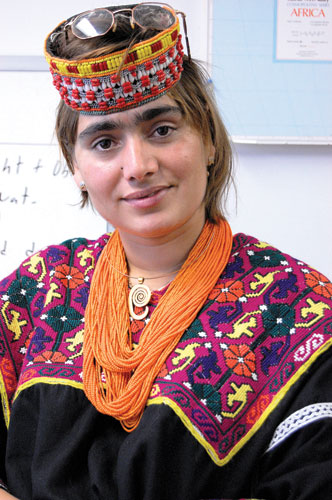|
saLT |
the-south-asian Life & Times April-June 2011 |
|
|||
|
Cover Story Lifestyle Aviation The
First Aerial Shots Trivandrum's
New Society Wildlife Corbett
Wildlife
Comment
|
|
||||
|
Lakshan Bibi
– "Yes, I am Kalasha’ By Mark Cherrington
She is a very serious, quietly intense woman who knows exactly what she wants and will not be deterred from getting it. Just as important, she has the experience and global savvy to make it happen. Lakshan Bibi was the first girl from her valley to go to graduate school (she earned a graduate degree from the University of Peshawar) and, improbably, became a commercial airline pilot—the first Kalasha woman ever to follow that path. Now she is a one-woman movement to restore the Kalasha people’s respect in the wider world and their pride in themselves. Kalasha are an endangered community of about 4,000 people in the Chitral Valley located between present-day Pakistan and Afghanistan. Rudyard Kipling’s The Man Who Would be King is a story about the land of Kafiristan, in the mountains between present-day Pakistan and Afghanistan. Kafiristan no longer exists as a country, but the people of Kipling’s story, the Kalasha, still live in that remote region. The Kalasha have a long and distinctive
history, which is both their source of pride and the source of their
persecution. They are unlike any of the surrounding peoples. Their physical
traits, in some ways, make them appear more European than subcontinental.
The Kalasha’s animist religion is based on mountain spirits and a yearly
cycle of ceremonies and sacrifices, and it predates Islam by at least 3,000
years. Based in three valleys and numbering between 3,000 and 4,000, the
Kalasha are farmers and goatherders, with goats having both spiritual and
economic importance. Perhaps the most distinctive element of Kalasha culture
is the women’s elaborate headdress, which features a long train called a
cupas, made of wool and decorated with rows of cowry shells, beads, buttons,
and bells. Along with the cupas, women traditionally wear long black dresses
with richly decorated shoulders and hems and topped with piles of bead
necklaces.
Read the entire article in the print
edition
|
|||||
|
Copyright © 2000 - 2011 [the-south-asian.com]. Intellectual Property. All rights reserved. |
|||||
